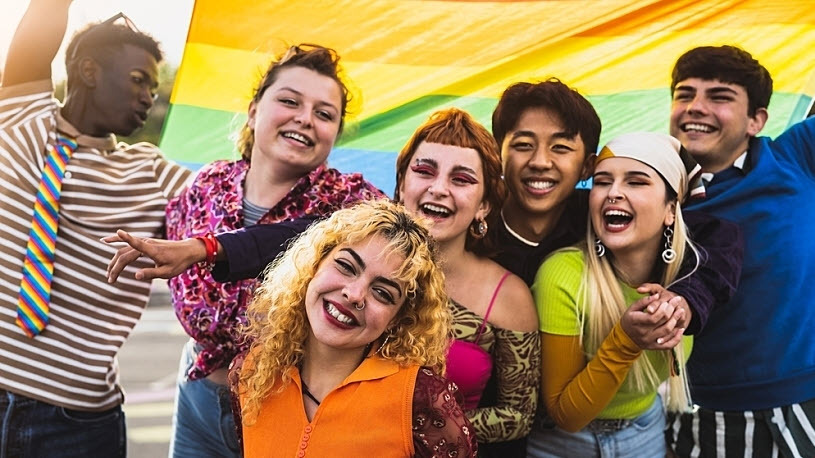10 Ways to Celebrate LGBTQ+ Pride Month at Work [2024 Update]

Celebrate LGBTQ+ Pride Month throughout June and year-round. Check out these 10 ways to celebrate and consider adding them to your agenda.
Every year in June, businesses celebrate LGBTQ+ Pride Month, highlighting the contributions of their LGBTQ+ workforces, raising awareness of challenges and opportunities for LGBTQ+ populations, offering related diversity, equity and inclusion (DE&I) resources and more. Celebrating the occasion can help leaders honor current and future members of their workforces and support continuing education and allyship in their workplaces and communities.
James McPhail, Employer Services International (ESI) business transformation director, ADP, and co-chair of ADP's Pride business resource group (BRG), says to consider establishing a theme as a first step. ADP's Pride Month theme for 2024 is "humanKind," emphasizing that, regardless of identity and orientation, everyone is human, more alike than they may think and should always strive to be kind in the spirit of this commonality.
"Setting a theme that works for you and your goals is crucial," McPhail says. "It can be incorporated across your events as a unique marker of your organization's celebration. Additionally, as you gather ideas and plan events, engage with HR, DE&I experts and your LGBTQ+ workforce to ensure a supportive, inclusive celebration. More than anything, take this opportunity to learn something new and have fun."
Below are 10 ways to celebrate LGBTQ+ Pride Month, inspired by the activities of ADP's Pride BRG.
1. Host a Pride Month parade
Consider participating in a local Pride Month parade or hosting your own. Discuss a vision, theme, schedule, duration, safety, transportation, floats, equipment and follow-up activities, such as lunch and games. Secure any needed permissions from local leaders and create promotional materials, float decorations and a soundtrack. If a city parade isn't feasible, consider an in-office, parking-lot or virtual parade, where employees log in to a virtual environment and give Pride Month presentations. If you have multiple locations, multiple parades can be organized. Or you could partner with nearby businesses to host a neighborhood or office-park parade. Additionally, consider incorporating a virtual viewing component for remote or hybrid employees. Share parade dates and times with your workforce and other attendees, and have the time of your life!
"Pride Month parades can be a rewarding and fun-loving experience. They are important for LGBTQ+ recognition and relationship-building. They create an environment that promotes joy and inclusivity, opening a space for others to come along, share in that joy and ask questions to learn more about LGBTQ+ communities," McPhail says. "Consider joining the fun and starting a virtual or in-person parade that your people will enjoy."
2. Ask LGBTQ+ people how to be supportive
What does it mean to be an effective LGBTQ+ ally? Ask a panel of LGBTQ+ employees to find out! Consider asking LGBTQ+ people in your workplace or community to participate, gathering questions anonymously so allies and would-be allies can inquire comfortably. Have a moderator oversee the exchange. If you need an example question, consider this: "How do I address someone or discuss their weekend with them if I don't know their partner's sex or gender identity?" Other conversation starters may include, "How do you ask someone for their pronouns or preferred or chosen name?"
"Asking clarifying, nonjudgmental questions is great. You may make an honest mistake in phrasing, and that's okay," McPhail says. "It shows that you're trying to learn and be inclusive. Be curious and ask questions; the more we learn, the more we can connect and understand each other."
3. Host a career development session
Consider asking LGBTQ+ leaders to discuss their careers and other professional experiences. This event may help LGBTQ+ communities grow their careers, leading to greater leadership representation in the long term.
An example question for this topic might be, "How has your gender identity or sexual orientation affected your career, if at all?" You could also discuss how understanding everyone's unique strengths can help facilitate higher employee engagement.
"This event puts LGBTQ+ representation in the spotlight, allowing your LGTBQ+ workforce to 'see' themselves in leaders who are like them and who have overcome obstacles faced by LGBTQ+ communities," McPhail says.
4. Host a 'plus' panel
Gather panelists who identify with the "plus" in "LGBTQ+" and ask, "What's your 'plus?'" This event may help your workforce learn more about people who don't identify as lesbian, gay, bisexual, transgender or queer (LGBTQ). What's part of the "plus," you might ask? Some members of the LGBTQ+ community identify as asexual, nonbinary or pansexual, for example.
ADP's Pride BRG has used the organization's workplace and community networks to locate people who share "plus" identities; could you do something similar? Ask a moderator to oversee the discussion, and gather questions anonymously. Assuming you've secured the appropriate employee permissions, consider recording the conversation for future viewing and for incorporation into your DE&I training. Remember that some community members aren't comfortable discussing their identities, so this event may not suit you or them. Be judicious, and always consult expert sources or resources when in doubt.
"Unfortunately, it's easy to overlook the 'plus,' as these identities can be less common," McPhail says. "This event includes people in this group and spotlights their experiences for all to listen to and learn from. Educationally, it's a great choice and may even be a source of inspiration for future DE&I instruction or for supporting others on their journeys to discover who they truly are."
5. Organize mental wellness activities
According to the Substance Abuse and Mental Health Services Administration's (SAMHSA's) Lesbian, Gay and Bisexual Behavioral Health National Surveys on Drug Use and Health:
- Women who identified as lesbian, gay or bisexual were more likely than straight women to have had any mental illness* or serious mental illness** in the past year.
- Men who identified as gay or bisexual were at least twice as likely as straight men to have had any mental illness in the past year. The prevalence of serious mental illness in the past year was more than three times higher among bisexual men than among straight men and more than twice as high among gay men than among straight men.
Taking these facts into account, as you plan, consider collaborating with mental health professionals to provide related content and activities tailored to the needs of your LGBTQ+ workforce.
*"Any mental illness" refers to the presence of a mental, behavioral or emotional disorder in the past year of sufficient duration to meet criteria from the Diagnostic and Statistical Manual of Mental Disorders, 4th edition, excluding developmental disorders and substance use disorders.
**"Serious mental illness" refers to the presence of a mental, behavioral or emotional disorder that substantially interfered with or limited one or more major life activities.
6. Celebrate Spirit Day in October
While you can consider offering anti-bullying awareness activities during Pride Month, consider also dedicating efforts to anti-bullying for Spirit Day, observed on the third Thursday in October. To join the movement, you could host workshops on combating common forms of bullying experienced by LGBTQ+ communities and on creating a safer, more inclusive workplace for all.
7. Launch a podcast or video series
In June, consider launching a weekly podcast or video series featuring conversations on the nuances of identities, allyship and LGBTQ+ experiences. In 2024, ADP's Pride BRG is hosting a similar podcast series featuring leaders in Arizona, Georgia, Canada and Romania. Consider a similar effort for your organization. Recruit employees, thought leaders and experts to share their insights and experiences.
8. Host an allyship panel
Gather a panel of allies to discuss practical ways to support LGBTQ+ communities. Your LGBTQ+ workforce or employee resource group (ERG) could recommend or nominate allies. The panelists could provide examples of allyship in action, effective ways to express allyship and the importance of allyship in general. Consider asking the panelists to share real-life examples of their allyship and what impact they believe it has had. This is also an excellent opportunity to ask members of your LGBTQ+ workforce how they think allyship could be improved, whether at your organization or in general.
"Unlike the panel comprising LGBTQ+ community members, this event puts LGBTQ+ allies in the driver's seat to educate other allies or would-be allies," McPhail says. "If you do both events, you'll be giving airtime to both perspectives, which is a win for inclusion in the workplace."
9. Offer inclusion-first learning opportunities
Discuss inclusive language or inclusive leadership during a live or prerecorded training session. Ask DE&I experts to discuss what being an inclusive leader looks like and examples of language that can help foster LGBTQ+ inclusion. Examples of topics include pronouns and preferred or chosen names, which are significant to many transgender and nonbinary people. Leave time for questions, and record the sessions for future reference or for incorporation into your DE&I training. Note that some may ask questions a certain way because they are learning to adopt an inclusive vocabulary. Patience, kindness and curiosity go a long way.
"My favorite thing about this event is that I can share how best to include LGBTQ+ associates and ensure that they know they belong," says Sara Holquist, director, diversity and corporate social responsibility (CSR), ADP. "In the past, attending sessions like this helped me significantly uplevel my inclusive leadership skills, identify areas where I may need to improve and educate others to do the same."
Watch this video on leading with inclusion for more on inclusive leadership.
10. Examine your business
Examine your business for inclusive policies, practices, products, services and communications. Consider these eight questions during your analysis:
- Are you following laws and best practices that protect LGBTQ+ people from discrimination?
- Do you have policies that create a safe and welcoming working environment for LGBTQ+ communities?
- Are your LGBTQ+ employees paid fairly?
- Are you using inclusive language in your communications?
- Does intersectionality factor into your LGBTQ+ commitments?
- Does your HR or other employee-facing software let employees self-identify (self-ID) their gender or as LGBTQ+; select nonbinary pronouns and salutations; and list preferred or chosen names? This approach can help you recognize and value the identities of LGBTQ+ communities.
- Can you view the binary and nonbinary distribution of your workforce and compare it with industry benchmarks?
- Can you use this data to enable compliance with reporting laws and make DE&I, hiring, retention and benefits decisions that support your LGBTQ+ workforce?
If analyzing your business this way feels overwhelming or uncomfortable, Pride Month is a great time to consult experts for guidance. Small steps are important and valued. Start lightly, and build upon past efforts year after year.
Committing to LGBTQ+ inclusion year-round
Celebrating LGBTQ+ Pride Month should be a year-round affair involving inclusive, data-driven HR software. Managers, supervisors and practitioners can use this technology to include their LGBTQ+ employees and strategically improve DE&I, hiring, retention, perks and benefits for their LGBTQ+ workforces.
Learn how ADP's solutions can help you create a more inclusive workplace. View the guide.
"At ADP, we iterate and consider the feedback of LGTBQ+ voices to refine the design of our products and services in a flexible, relevant and inclusive way. We encourage our clients and prospects to consider the same," says Giselle Mota, chief of product inclusion, ADP. "In addition to delivering employee self-ID features, we continue to take feedback and make updates using a phased approach. This is what making HR and payroll solutions truly human looks like."
ADP's Pride BRG inspired and contributed to this article. The Pride BRG is a supportive place for ADP's LGBTQ+ associates and their allies.



